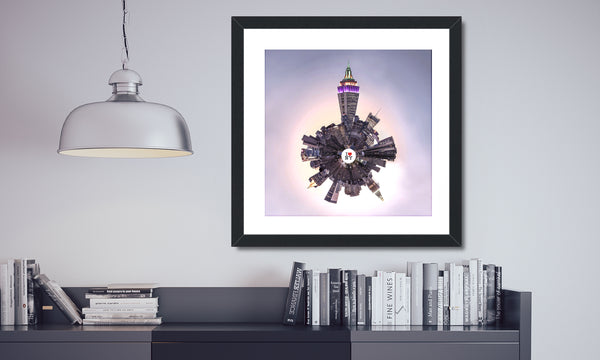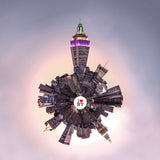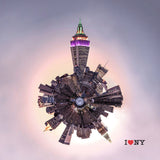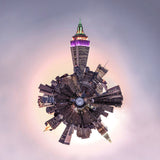I♥NY
006 Pastel Empire State Top - NYC Skyline
I LOVE NY | Pastel Empire State Tops NYC Skyline
NYC006
New York, NY
Dusk_Empire State Building lit in pastel pink and yellow a top the New York City horizon
Panorama photography shot from across the East River looking towards Empire State Building
16”x16” quality print with many framing options
The Heart of New York City
A SWIRLING SKYLINE PANORAMA of east side of Manhattan NY at dusk, especially highlighting the Empire State Building, with the NY Life Building and the The Metropolitan Life Insurance Company Tower, The New York Times Building, and the Merchandise Mart. Skyline photography of New York City from across the river, with favorite notable NY building highlights.
THE BEST OF MIDTOWN NEW YORK CITY in a I LOVE NY pastel colored bubble.
THIS HIGH QUALITY 16” x 16” print is available in a variety of framing options to compliment any décor. Get your limited edition unique slice of the Big Apple, or delight your New York friends with the perfect holiday, birthday or housewarming gift!
The City of New York, often called New York City or simply New York, is the most populous city in the United States. With an estimated 2015 population of 8,550,405 distributed over a land area of about 302.6 square miles (784 km2), New York City is also the most densely populated major city in the United States. Located at the southern tip of the state of New York, the city is the center of the New York metropolitan area, one of the most populous urban agglomerations in the world. A global power city, New York City exerts a significant impact upon commerce, finance, media, art, fashion, research, technology, education, and entertainment, its fast pace defining the term New York minute.Home to the headquarters of the United Nations, New York is an important center for international diplomacy and has been described as the cultural and financial capital of the world.
Situated on one of the world's largest natural harbors, New York City consists of five boroughs, each of which is a separate county of New York State. The five boroughs – Brooklyn, Queens, Manhattan, The Bronx, and Staten Island – were consolidated into a single city in 1898. The city and its metropolitan area constitute the premier gateway for legal immigration to the United States, and as many as 800 languages are spoken in New York, making it the most linguistically diverse city in the world.[33][35][36] By 2015 estimates, the New York City metropolitan region remains by a significant margin the most populous in the United States, as defined by both the Metropolitan Statistical Area (MSA), 20.2 million residents,[5] and the Combined Statistical Area (CSA), 23.7 million residents. In 2013, the MSA produced a gross metropolitan product (GMP) of nearly US$1.39 trillion. In 2012, the CSA generated a GMP of over US$1.55 trillion. NYC's MSA and CSA GDP are higher than all but 11 and 12 countries, respectively.
Facts about the Empire State Building
The Empire State Building is a 102-story skyscraper located on Fifth Avenue between West 33rd and 34th Streets in Midtown, Manhattan, New York City. It has a roof height of 1,250 feet (381 m), and with its antenna included, it stands a total of 1,454 feet (443.2 m) tall.[7] Its name is derived from the nickname for New York, the Empire State. It stood as the world's tallest building for nearly 40 years, from its completion in early 1931 until the topping out of the original World Trade Center's North Tower in late 1970. Following the September 11 attacks in 2001, the Empire State Building was again the tallest building in New York, until One World Trade Center reached a greater height in April 2012. The Empire State Building is currently the fifth-tallest completed skyscraper in the United States and the 34th-tallest in the world. It is also the fifth-tallest freestanding structure in the Americas. When measured by pinnacle height, it is the fourth-tallest building in the United States.
The Empire State Building was designed by William F. Lamb from the architectural firm Shreve, Lamb and Harmon, which produced the building drawings in just two weeks, using its earlier designs for the Reynolds Building in Winston-Salem, North Carolina, and the Carew Tower in Cincinnati, Ohio (designed by the architectural firm W. W. Ahlschlager & Associates) as a basis. Every year the staff of the Empire State Building sends a Father's Day card to the staff at the Reynolds Building in Winston-Salem to pay homage to its role as predecessor to the Empire State Building. The building was designed from the top down.
The building's art deco design is typical of pre–World War II architecture in New York. The modernistic stainless steel canopies of the entrances on 33rd and 34th Streets lead to two story-high corridors around the elevator core, crossed by stainless steel and glass-enclosed bridges at the second-floor level. The elevator core contains 67 elevators.[16]
The lobby is three stories high and features an aluminum relief of the skyscraper without the antenna, which was not added to the spire until 1952. The north corridor contained eight illuminated panels, created by Roy Sparkia and Renée Nemorov in 1963 in time for the 1964 World's Fair, which depicts the building as the Eighth Wonder of the World, alongside the traditional seven. These panels were eventually moved near a ticketing line for the observation deck.
Until the 1960s, the ceilings in the lobby had a shiny art deco mural inspired by both the sky and the Machine Age, until it was covered with ceiling tiles and fluorescent lighting. Because the original murals, designed by an artist named Leif Neandross, were damaged, reproductions were installed. Over 50 artists and workers used 15,000 square feet of aluminum and 1,300 square feet of 23-carat gold leaf to re-create the mural. Renovations to the lobby alluded to original plans for the building; replacing the clock over the information desk in the Fifth Avenue lobby with an anemometer, as well as installing two chandeliers originally intended to be part of the building when it first opened.[64] In 2000, the building's owners installed a series of paintings by the New York artist Kysa Johnson in the concourse level. In January 2014 the artist filed suit in federal court in New York under the Visual Artists Rights Act, alleging the negligent destruction of the paintings and damage to her reputation as an artist.
Facts about New York Life Insurance Company Building
51 Madison Avenue (aka 45-55 Madison Avenue, 31-51 East 26th Street, 24-50 East 27th Street, and 364-378 Park Avenue South), Manhattan. Built 1926-28; Cass Gilbert, architect.
The History
Built in 1928 by Cass Gilbert, designer of the landmark Woolworth Building, this massive 40-story structure is topped by a golden pyramid roof and occupies a site with an equally grand history. From 1837-1889, the land was home to the New York, New Haven and Hartford Railroad depot, a concert garden and P.T. Barnum's Hippodrome. Until 1925, the site housed the original Madison Square Garden, designed by architect Stanford White.
Architectural Features
Pass through the grand bronze entryway doors, and you'll find yourself in a lobby that seems infinite, illuminated with the hushed glow of 18 enormous hanging lamps. Even if you're just taking the grand stairway to the subway station in the bottom of the building, be sure to look up on your short journey, or risk missing the elaborate coffered and vaulted ceilings.
Summary
The 40-story tower (thirty-four stories plus the six-story crown) for the New York Life Insurance Company, one of the "big three" insurance companies, was designed by noted architect Cass Gilbert in 1926 and constructed in 1927-28. The building is Gilbert's third and final version of the neo-Gothic skyscraper in New York City, following the successful use of the style for 90 West Street in 1907 and later for the 1913 Woolworth Building (both designated New York City Landmarks). With the New York Life Insurance Company design, Gilbert melded the neo-Gothic embellishments of his earlier buildings with the cubic geometries of 1920s skyscrapers, making this building a significant transition from the historical revival-style skyscrapers of the 1900s to the Art Deco towers of the late 1920s. New York Life's desire for a monumental headquarters building allowed Gilbert to finally achieve his wish of creating a skyscraper clad in stone. Details included the richly-molded surrounds of the entrance, window spandrels, and gargoyles at the roof line. The structure's pyramidal tower makes the building a distinctive contribution to the Madison Square neighborhood and the New York City skyline. The New York Life Insurance Compant was founded in 1841 as the Nautilus Insurance Company in New York City. The building was constructed during the administration of President Darwin P. Kingsley, an internationally-renowned businessman who expanded the firm's operations and developed new types of insurance policies. The New York Life Building, the most prominent insurance company building constructed between World War I and the Great Depression, was also the last signature home office building constructed for an insurance company in New York City. It was designed to protect a strong corporate image through its siting, style, and silhouette. Rising above Madison Square Park, the building is a powerful symbol of the New York Life Insurnace Company's lasting stability.
Facts about Metropolitan Life Insurance Company Tower
The Metropolitan Life Insurance Company Tower, colloquially known as the Met Life Tower, is a landmark skyscraper located on Madison Avenue near the intersection with East 23rd Street, across from Madison Square Park in Manhattan, New York City. Designed by the architectural firm of Napoleon LeBrun & Sons and built by the Hedden Construction Company, the tower is modeled after the Campanile in Venice, Italy. The hotel located in the clock tower portion of the building has the address 5 Madison Avenue, while the office building covering the rest of the block, occupied primarily by Credit Suisse, is referred to as 1 Madison Avenue. Inside the building is the New York Edition Hotel, a 273-room luxury hotel that opened in 2015.
The tower was a later addition to the original 11-story, full-block Metropolitan Life Home Office building (the "East Wing"), which was completed in 1893 and was also designed by Napoleon LeBrun & Sons.[10] Plans for the tower were first announced in 1905. In 1953-57, the original Home Office building was replaced with the current building, designed by D. Everett Waid. Then, between 1960 and 1964, the Tower itself was modernized by Lloyd Morgan and Eugene V. Meroni.
There are four clock faces, one on each side of the tower, located from the 25th to 27th floors. Each clock face is 26.5 feet (8 m) in diameter with each number being four feet (1.2 m) tall. The minute hands each weigh half a ton.[citation needed] The original tower was sheathed in Tuckahoe marble, but during the 1964 renovation plain limestone was used to cover the tower and the East Wing, replacing the old Renaissance revival details with a streamlined, modern look.
Facts About New York Times Building
The New York Times Building, at 41 Park Row in the Civic Center neighborhood of Manhattan, New York City, was the home of The New York Times from 1889 to 1903, when it moved to Longacre Square, now known as Times Square. The building stands as the oldest of the surviving buildings of what was once "Newspaper Row", and is owned by Pace University. A bronze statue of Benjamin Franklin holding a copy of his Pennsylvania Gazette stands in front of the building in Printing-House Square, currently known as 1 Pace Plaza.
The History
The newspaper's first building was located at 113 Nassau Street in New York City. In 1854, it moved to 138 Nassau Street, and in 1858 it moved to a five-story building designed by Thomas R. Jackson in the Romanesque Revival style at 41 Park Row, – until then the site of the Brick Presbyterian Church – making it the first newspaper in New York City housed in a building built specifically for its use.[2] The 1851 building, located across from City Hall and dwarfing that of Horace Greeley's New York Tribune, was described by the Times in 2001 as "a declaration that the newspaper regarded itself as a powerful institution in civic life.... No politician standing on the broad steps of City Hall could fail to note the newspaper's presence. And after 1871, when The Times led the crusade against the Tweed Ring, no politician could afford to ignore it."[2]
After Greeley's Tribune raised the stakes with a taller building of its own in the 1870s, the Times responded in 1889 with a commission for architect George B. Post to design a grander — and taller — building at 41 Park Row to replace the existing structure. The 13-story Romanesque building, with arches carved from Maine granite and Indiana limestone, was constructed around the core of the original building. The printing presses were kept in place, and the new building constructed around it as the old one was demolished – this space was later used by Pace University as a gym.[3] The top floor was designated for use by the composing room to allow the printers access to more natural light.








